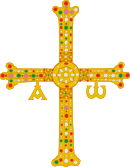| Church of St. John Apostle and Evangelist Iglesia de San Juan Apóstol y Evangelista (in Spanish) | |
|---|---|
 | |
| Religion | |
| Affiliation | Roman Catholic |
| Province | Asturias |
| Ecclesiastical or organizational status | Church |
| Location | |
| Location | Santianes de Pravia, Spain |
| Geographic coordinates | 43°30′07.02″N 6°05′56.92″W / 43.5019500°N 6.0991444°W |
| Architecture | |
| Type | Church |
| Style | Pre-Romanesque |
| Groundbreaking | 774 |
| Completed | 783 |
| Website | |
| Official Website | |
St. John Apostle and Evangelist (Spanish: Iglesia de San Juan Apóstol y Evangelista[pronunciation?]) is a Roman Catholic Asturian pre-Romanesque church situated in Santianes de Pravia, northern Spain.
Cultural references


The church contains a foundation stone in the form of a letter labyrinth ("Silo Princeps Fecit") that records the 8th-century founding of the church by King Silo of Asturias. The inscription Silo princeps fecit singularly combined in fifteen horizontal lines and nineteen perpendicular columns of letters. The T forms the beginning and the end of the first and last line in consequence of which the name Silo is not to be found till the eighth line and the S which begins it is exactly in the centre of that line and of the tenth column thus the name is in the shape of a cross as the letters above below and on each side of the S form the word Silo.
This letter labyrinth appears to inspire the hypercube of Salvador Dalí's painting A Propos of the "Treatise on Cubic Form" by Juan de Herrera, housed in the Museo Reina Sofia, Madrid.

